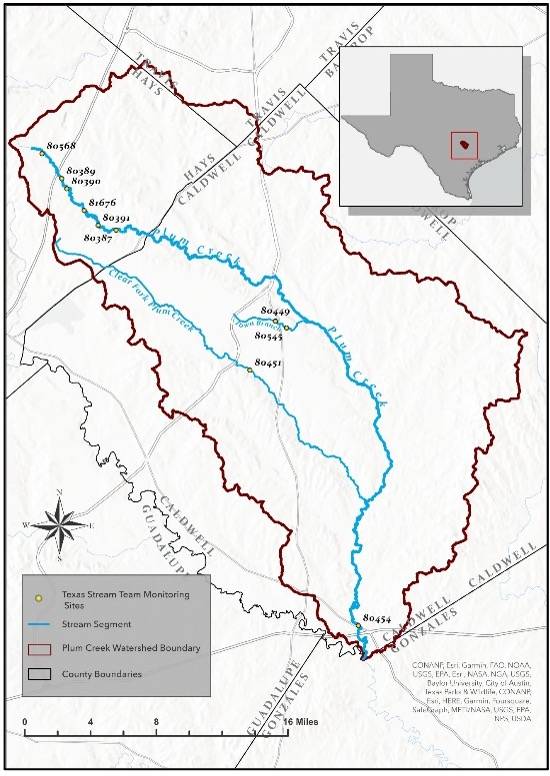Plum Creek Watershed Data Summary Report

Every quarter, Texas Stream Team analyzes data collected by community scientists in a specific watershed and presents the findings in Data Summary Reports. These reports highlight trends, environmental factors, Texas Stream Team activities, and more within the selected watershed. This quarter, the Plum Creek watershed was selected for the analysis and extends to Hays, Travis, Caldwell, and Gonzales counties in Texas (Figure 1).
Texas Stream Team community scientists monitored standard core and E. coli bacteria parameters intermittently at ten sites in the Plum Creek watershed from December 2006 to September 2023. Of the ten sites monitored, seven were on Plum Creek (segment 1810), two were on Town Branch (segment 1810A), and one was on Clear Fork Creek (no segment number assigned). All ten sites had ten or more monitoring events conducted at each site.
Parameters monitored by Texas Stream Team community scientists included water and air temperature, specific conductance, total dissolved solids, dissolved oxygen, pH, transparency, total depth, and E. coli bacteria. No advanced nutrient parameters were monitored as part of this effort. Data from the ten monitoring sites were analyzed and summarized in this report.
While the 2022 Texas Integrated Report of Surface Water Quality for Clean Water Act Sections 305(b) and 303(d) (2022 Integrated Report) prepared by the Texas Commission on Environmental Quality (TCEQ) did not identify any impairments in Plum Creek (segment 1810), nutrient and bacteria concerns were identified in the late 1990s and early 2000s. Community scientists did not monitor nutrients, therefore no nutrient data was available for this summary report. Similarly, E. coli bacteria was only monitored at one site five times, so only a limited historical data set was included in this report.
To evaluate water quality, we compared water quality standards for designated uses in the watershed. Discreet measurements from all sites evaluated met the water quality standard for temperature (32.2°C), total dissolved solids (1,120 mg/L), and pH (6.5 and 9.0 s.u.) during the period of record for this report. However, discreet measurements for temperature and pH exceeded the corresponding water quality standard at the Plum Creek site located at the golf course on Fairway Street (80568) at least once.
For the period of record of this study, the average dissolved oxygen values for all sites in the watershed met the average water quality standard of 5.0 mg/L. However, most sites did not meet the minimum standard of 4.0 mg/L at some point during the period of record, except for Plum Creek (site 80389) and Town Branch (site 89545). Although no impairments for dissolved oxygen were identified in the 2022 Integrated Report prepared biennially by TCEQ, the area is showing signs of concern based on the results of this work. Dissolved oxygen levels are affected by nutrient enrichment, resulting in eutrophication. Plum Creek was impaired for nutrients in the late 1990s. Therefore, monitoring nutrients to better understand the interaction between nutrient loadings and dissolved oxygen is imperative. With the growing human population and increased development in the headwaters of the watershed and throughout the central Texas Hill Country, these findings should concern residents and decision-makers alike.
The Texas Stream Team community scientists monitoring Standard Core water quality parameters in the watershed are encouraged to continue monitoring, consider adding the advanced parameters of nutrients to their current monitoring efforts, and increase bacteria monitoring at other sites in the watershed. Continuation of the ongoing monitoring is crucial due to the results presented here and the increased development in the watershed and the surrounding central Texas Hill Country. Continued water quality monitoring is important for developing long-term data sets that describe current water quality conditions and for historical and future trends to capture changes in water quality as the area grows.
Texas Stream Team will continue to support community scientists by providing technical support, creating new monitoring sites, and re-activating existing sites. We look forward to training new community scientists to expand, grow, and sustain the water quality monitoring efforts in this area and beyond. For more information about Texas Stream Team and upcoming trainings, contact us at TxStreamTeam@txstate.edu or visit the calendar of events on our website at www.TexasStreamTeam.org.
